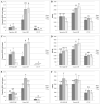Post-mating change in excretion by mated Drosophila melanogaster females is a long-term response that depends on sex peptide and sperm
- PMID: 23891750
- PMCID: PMC3923306
- DOI: 10.1016/j.jinsphys.2013.07.001
Post-mating change in excretion by mated Drosophila melanogaster females is a long-term response that depends on sex peptide and sperm
Abstract
Drosophila seminal fluid proteins elicit physiological and behavioral changes in the female after mating. For example, the seminal protein sex peptide (SP) causes females to lay more eggs, reduce receptivity to re-mating, consume more food and produce more concentrated excreta upon mating. It has been reported that SP indirectly increases food consumption as a result of its stimulation of egg production, but its role in producing more concentrated excreta in the mated female was reported to be independent of egg production. Additionally, it has been shown that SP's effect on food consumption persists for several days after mating, while it is unknown whether this is true for its effect on excretion. SP can have both transient and long-term effects on mated females; the latter occur because of the peptide's binding to, and slow release from, sperm in the female. Here we used timed measures of excretion by female flies that had mated to males mutant in SP or in its regulators, to test the duration of SP's effect on excretion. We found that SP's effect on excretion persists for at least ~1 week after mating, and that this persistence requires that SP bind to and be released from sperm. Although these binding/release requirements of SP are similar to those for increased egg production (and consequent increased food intake) following mating, we find that the long-term change in excretion phenotype is only partially dependent on the presence of eggs in the female. Our data indicate that a change in intestinal transit is part of the long-term post-mating response elicited by the gradual release of sperm-bound SP in the female after mating, even though it is not fully dependent on other long-term responses elicited by SP.
Keywords: Drosophila melanogaster; Excretion; Feeding; Post-mating response; Sex peptide; Sperm.
Copyright © 2013 Elsevier Ltd. All rights reserved.
Figures




References
-
- Boswell RE, Mahowald AP. Tudor, a gene required for assembly of the germ plasm in Drosophila melanogaster. Cell. 1985;43:97–104. - PubMed
-
- Chapman T, Partridge L. Female fitness in Drosophila melanogaster: An interaction between the effect of nutrition and of encounter rate with mates. Proceedings: Biological Sciences. 1996;22:755–759. - PubMed
Publication types
MeSH terms
Substances
Grants and funding
LinkOut - more resources
Full Text Sources
Other Literature Sources
Molecular Biology Databases

